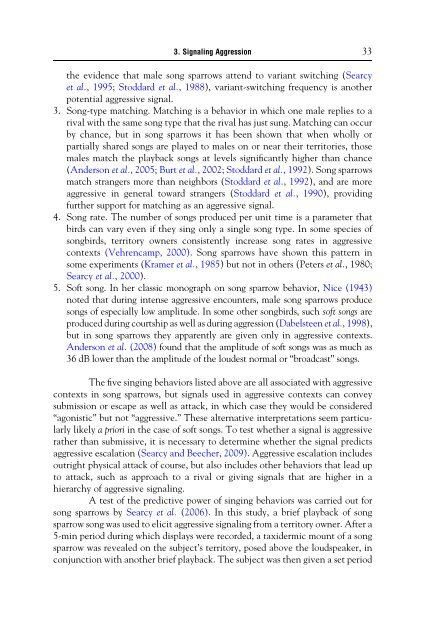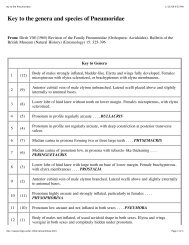full text - Caspar Bgsu - Bowling Green State University
full text - Caspar Bgsu - Bowling Green State University
full text - Caspar Bgsu - Bowling Green State University
You also want an ePaper? Increase the reach of your titles
YUMPU automatically turns print PDFs into web optimized ePapers that Google loves.
3. Signaling Aggression 33<br />
the evidence that male song sparrows attend to variant switching (Searcy<br />
et al., 1995; Stoddard et al., 1988), variant-switching frequency is another<br />
potential aggressive signal.<br />
3. Song-type matching. Matching is a behavior in which one male replies to a<br />
rival with the same song type that the rival has just sung. Matching can occur<br />
by chance, but in song sparrows it has been shown that when wholly or<br />
partially shared songs are played to males on or near their territories, those<br />
males match the playback songs at levels significantly higher than chance<br />
(Anderson et al., 2005; Burt et al., 2002; Stoddard et al., 1992). Song sparrows<br />
match strangers more than neighbors (Stoddard et al., 1992), and are more<br />
aggressive in general toward strangers (Stoddard et al., 1990), providing<br />
further support for matching as an aggressive signal.<br />
4. Song rate. The number of songs produced per unit time is a parameter that<br />
birds can vary even if they sing only a single song type. In some species of<br />
songbirds, territory owners consistently increase song rates in aggressive<br />
con<strong>text</strong>s (Vehrencamp, 2000). Song sparrows have shown this pattern in<br />
some experiments (Kramer et al., 1985) but not in others (Peters et al., 1980;<br />
Searcy et al., 2000).<br />
5. Soft song. In her classic monograph on song sparrow behavior, Nice (1943)<br />
noted that during intense aggressive encounters, male song sparrows produce<br />
songs of especially low amplitude. In some other songbirds, such soft songs are<br />
produced during courtship as well as during aggression (Dabelsteen et al.,1998),<br />
but in song sparrows they apparently are given only in aggressive con<strong>text</strong>s.<br />
Anderson et al. (2008) found that the amplitude of soft songs was as much as<br />
36 dB lower than the amplitude of the loudest normal or “broadcast” songs.<br />
The five singing behaviors listed above are all associated with aggressive<br />
con<strong>text</strong>s in song sparrows, but signals used in aggressive con<strong>text</strong>s can convey<br />
submission or escape as well as attack, in which case they would be considered<br />
“agonistic” but not “aggressive.” These alternative interpretations seem particularly<br />
likely a priori in the case of soft songs. To test whether a signal is aggressive<br />
rather than submissive, it is necessary to determine whether the signal predicts<br />
aggressive escalation (Searcy and Beecher, 2009). Aggressive escalation includes<br />
outright physical attack of course, but also includes other behaviors that lead up<br />
to attack, such as approach to a rival or giving signals that are higher in a<br />
hierarchy of aggressive signaling.<br />
A test of the predictive power of singing behaviors was carried out for<br />
song sparrows by Searcy et al. (2006). In this study, a brief playback of song<br />
sparrow song was used to elicit aggressive signaling from a territory owner. After a<br />
5-min period during which displays were recorded, a taxidermic mount of a song<br />
sparrow was revealed on the subject’s territory, posed above the loudspeaker, in<br />
conjunction with another brief playback. The subject was then given a set period



